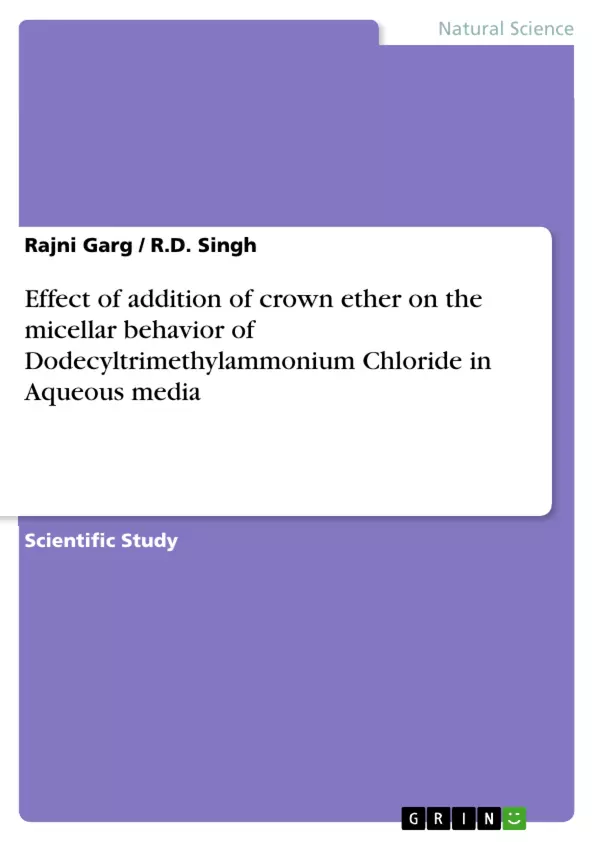The micellar properties of cationic dodecyltrimethylammonium chloride (DTAC) in aqueous media in the presence of 15-crown-5ether (CR) have been investigated by conductivity measurements over the temperature range 288.15-308.15 K. The results of the ternary DTAC/CR/W system were analysed in comparison with the reported results of binary DTAC/W system. The critical aggregation concentration (cac) and degree of ionization of the micelles were determined from the conductivity measurements at different temperatures. Thermodynamic parameters for the micellar system were estimated by applying the charged pseudo-phase separation model. Micellisation was found to be spontaneous and entropy-driven.
Inhaltsverzeichnis (Table of Contents)
- Introduction
- Experimental
- Materials
- Methods
- Results and Discussion
Zielsetzung und Themenschwerpunkte (Objectives and Key Themes)
This research investigates the impact of adding 15-crown-5 ether (CR) to aqueous solutions of dodecyltrimethylammonium chloride (DTAC) on micellar properties. The study aims to determine the critical aggregation concentration (cac) and the degree of counterion dissociation (ß) in the presence of the crown ether. Additionally, the research explores the thermodynamic parameters associated with micelle formation, including the standard free energy (AG), enthalpy (AH), and entropy (AS) of micellisation.
- Impact of crown ether on the micellar behavior of DTAC
- Determination of critical aggregation concentration (cac)
- Evaluation of the degree of counterion dissociation (ß)
- Thermodynamic analysis of micellisation
- Influence of temperature on micellar properties
Zusammenfassung der Kapitel (Chapter Summaries)
- Introduction: This section provides an overview of the importance of surfactant organized assemblies and discusses the influence of various additives on micellar properties. It highlights the significance of crown ethers as macrocyclic ligands and their ability to complex with counterions, leading to alterations in micellar behavior.
- Experimental: This chapter outlines the materials used in the research, including 15-crown-5 ether (CR), dodecyltrimethylammonium chloride (DTAC), and deionized water. The conductivity technique employed to measure the properties of the ternary DTAC/CR/W systems is described in detail, along with the temperature range and the specific methodology.
- Results and Discussion: This section presents the conductivity data obtained for the ternary DTAC/CR/W systems at various temperatures. The cac and ß values are determined from the conductivity-concentration plots. The influence of temperature on cac and ß is discussed, along with the thermodynamic parameters AG, AH, and AS derived from the charged pseudo-phase separation model.
Schlüsselwörter (Keywords)
The key terms and concepts of the research include crown ethers, dodecyltrimethylammonium chloride (DTAC), critical aggregation concentration (cac), degree of ionization, micellisation, thermodynamic parameters, conductivity measurements, and charged pseudo-phase separation model.
- Quote paper
- Rajni Garg (Author), R.D. Singh (Author), 2011, Effect of addition of crown ether on the micellar behavior of Dodecyltrimethylammonium Chloride in Aqueous media , Munich, GRIN Verlag, https://www.grin.com/document/183933



